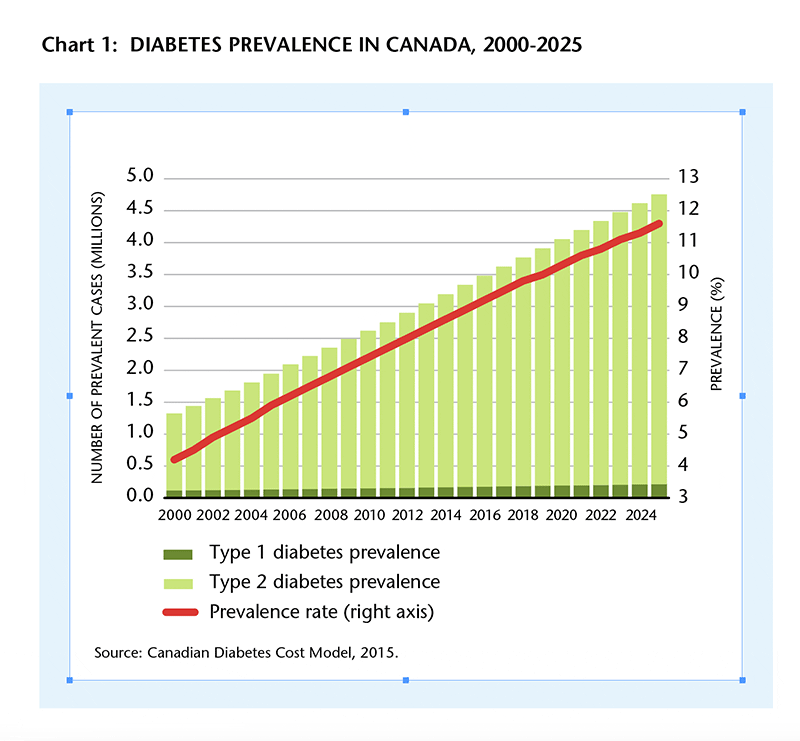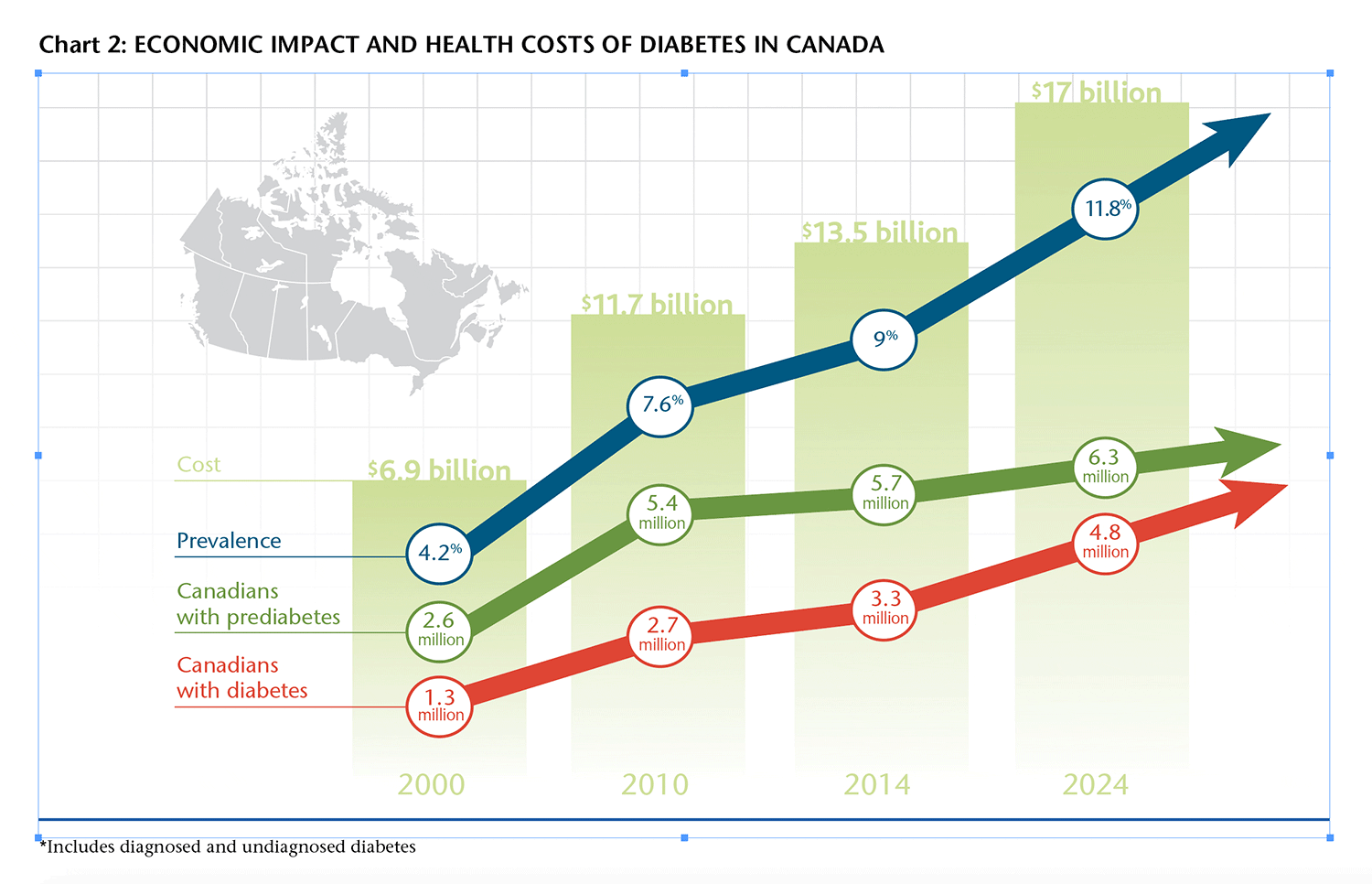Canada’s Silent Epidemic: One Canadian in Three is Threatened by Diabetes
Kimberley Hanson
One of the great ironies of public health trends in the 21st century is that, despite the heightened awareness of—and globalization of information availability on—chronic disease prevention, diabetes rates are skyrocketing. The good news is that lifestyle changes can prevent many people from developing the disease or its complications. But Canada needs an action plan.
You’re at a dinner party or at work. Look to your left. Look to your right. Wherever you may be, if you’re in Canada, the chances are that either you or one of the people next to you has diabetes.
Today, four million Canadians have been diagnosed with diabetes, of whom approximately 300,000 have Type 1, while the rest have Type 2. An additional one million Canadians are estimated to be living with undiagnosed Type 2 diabetes. Six million more Canadians are estimated to be living with prediabetes. Altogether, 11 million Canadians—nearly one Canadian in three—are living with or threatened by diabetes. Globally, diabetes cases worldwide more than doubled during the past 20 years.
By any definition, diabetes, which affects over 400 million people worldwide, is a pandemic.
Yet it’s not a health crisis Canadians on the whole seem proportionally concerned about. The last national diabetes strategy fizzled away in 2014 following a scathing report on its underperformance by the Auditor General. All that remains of our previous national strategy is the Aboriginal Diabetes Initiative. The 2018 federal budget contained only one mention of the word diabetes in its 367 pages. Clearly, improving the prevention and management of diabetes is not a top priority for our country.
But should it be? It should come as no surprise that as a representative of Diabetes Canada—the national patient advocacy organization on the disease—and as a person with nearly a quarter century’s experience living with Type 1 diabetes, I am arguing that it should.
First, a refresher on the disease: Diabetes is a metabolic disorder in which the body either cannot produce insulin or cannot properly use the insulin it produces. Insulin is a hormone that controls the amount of glucose (sugar) in the blood. The body needs insulin to use sugar as an energy source. Diabetes leads to high blood sugar levels, which can damage organs, blood vessels and nerves.
There are three types of diabetes:
• Type 1 diabetes, which is an auto-immune condition that generally develops in childhood or adolescence, and occurs when the body does not produce insulin (or produces very little) and requires the daily administration of insulin.
• Type 2 diabetes results from the body’s ineffective use of insulin; when the body does not make enough insulin or cannot properly use the insulin it produces. This used to be a type of diabetes exclusively experienced by adults, but increasingly (and alarmingly) it is developing in children. “Type 2 diabetes comprises the majority of people with diabetes around the world, and is largely the result of excess body weight and physical inactivity,” according to the World Health Organization (WHO).
• Gestational diabetes is a temporary condition that develops during pregnancy and leads to increased risk of developing Type 2 diabetes for both mother and child.
In addition to these types of diabetes, there’s a precursor condition known as prediabetes. Prediabetes refers to blood glucose levels that are higher than normal, but not yet high enough to be diagnosed as Type 2 diabetes. Nearly 50 per cent of those with prediabetes will go on to develop Type 2 diabetes.
Globally, the number of adults living with diabetes has quadrupled since 1980, from just over 100 million to more than 400 million according to the World Health Organization 2016 Global Report on Diabetes. In 2012, the disease directly caused 1.5 million deaths and elevated blood glucose levels linked to diabetes were responsible for an additional 2.2 million deaths that year.
The International Diabetes Federation lists Canada in the bottom third of OECD (Organization for Economic Co-operation and Development) countries for diabetes prevalence. More than twice as many Canadians live with diabetes today as did in 2000. Both prevalence and direct costs of treating the disease in Canada have been rising at a rate of four per cent per year and show no signs of slowing down. Diabetes costs our health care system $3.6 billion per year in direct costs today, and that number will soar to nearly $5 billion within a decade.
And the best estimates suggest that the indirect costs of diabetes in lost productivity might add up to triple that amount. The personal toll on individuals and their families is incalculable.
People often express to me that they don’t think diabetes is a particularly serious disease, which illustrates how much is truly unknown. Diabetes-related complications can be serious and life-threatening. People with diabetes account for 30 per cent of the strokes, 40 per cent of heart attacks, 50 per cent of kidney failure requiring dialysis and 70 per cent of amputations in Canada each year. The life expectancy of a person with diabetes is shortened by an average of 13 years.
 Statistics Canada lists diabetes as the seventh leading cause of death in Canada, and a key contributor to people developing the top three causes (cancer, heart disease and stroke). Between 2004 and 2008, when rates of diabetes in Canada were much lower, diabetes contributed to an additional 10.6 per cent of all deaths. It is reasonable to assume that that rate has been maintained if not increased in the intervening years, which could mean that nearly 30,000 Canadians died of diabetes in 2015 (the last year for which data is available).
Statistics Canada lists diabetes as the seventh leading cause of death in Canada, and a key contributor to people developing the top three causes (cancer, heart disease and stroke). Between 2004 and 2008, when rates of diabetes in Canada were much lower, diabetes contributed to an additional 10.6 per cent of all deaths. It is reasonable to assume that that rate has been maintained if not increased in the intervening years, which could mean that nearly 30,000 Canadians died of diabetes in 2015 (the last year for which data is available).
With statistics like these, it’s easy to wonder why we’re not all panicking about this epidemic. And yet, like the proverbial frog in the pot, we seem unaware of the boiling water that surrounds us. It’s time for urgent change.
This is not a problem that will be addressed by personal willpower and shame. To blame and stigmatize those living with Type 2 diabetes for their disease is not only unhelpful, it is a vast oversimplification. Type 2 diabetes is caused by a complex array of factors including genetics, lifestyle and environmental factors such as poverty, reduced access to clean drinking water, food insecurity, and a disease-promoting food and physical environment.
To really turn the tide of the diabetes tsunami, we need a nationwide approach that helps all Canadians know the risks of diabetes, reduces individual risk factors, promotes healthier environments and creates measurable health outcomes for patients.
In 2018, Diabetes Canada is developing just such an approach. We’re building on a successful ‘90-90-90’ model implemented in the HIV/AIDS community and adapting it to tackle diabetes in Canada.
A ‘90-90-90’ approach was pioneered by Dr. Julio Montaner from the University of British Columbia and adopted globally to combat HIV/AIDS. Canada will be the first country to apply such a model to reduce the impact of diabetes and it has the potential to change the trajectory of this disease in our country.

Implementing a 90-90-90 approach would mean that, in time, 90 per cent of Canadians who are at risk for or living with diabetes would know their status, 90 per cent of those diagnosed with diabetes or prediabetes would be benefitting from healthier environments and appropriate interventions, and 90 per cent of them would be experiencing improved health outcomes.
This translates into millions of Canadians who are currently on track to develop diabetes avoiding that fate. Millions of Canadians with diabetes who are at risk of developing serious complications like blindness, kidney failure or amputation would see their risk reduced. And significant time and money would be saved by our health care system.
While it’s early in the process to identify the specifics of the 90-90-90 approach, there are some tantalizing possibilities. For example, we know from research that when someone who is at risk of developing Type 2 diabetes makes minor lifestyle adjustments (losing 5-10 per cent of their body weight, for example), they are 60 per cent less likely to develop the disease. That could mean that if we increase risk awareness, and then provide adequate support, we could help 3.5 million Canadians make meaningful changes to avoid or significantly delay developing diabetes.
To develop the best approach possible to tackling this problem, Diabetes Canada is working with expert stakeholders representing more than 80 organizations from coast to coast to coast to develop a recommendation for how Canada can implement a new approach that will bring real results.
Canada has a proud history of being on the forefront of diabetes treatment, including 1923 Nobel co-laureate Dr. Frederick Banting’s role in the discovery of insulin in Toronto. A decision by the federal government to support a 90-90-90 approach to diabetes could put Canada in a position of global leadership in the treatment of diabetes in time for the 100th anniversary of the discovery of insulin in 2021. That is something we could all be proud of.
Archbishop Desmond Tutu once said, “There comes a point where we need to stop just pulling people out of the river. We need to go upstream and find out why they’re falling in.”
When it comes to the millions upon millions of Canadians who already have or are well on their way to developing diabetes and its many complications, the time to move upstream and fix the problem is now. With expert guidance and input from hundreds of knowledgeable Canadians, Diabetes Canada plans to chart a path to doing just that.
Kimberley Hanson is Director of Federal Affairs at Diabetes Canada, responsible for advocacy with the federal government on national issues.
kimberley.hanson@diabetes.ca
SaveSave
